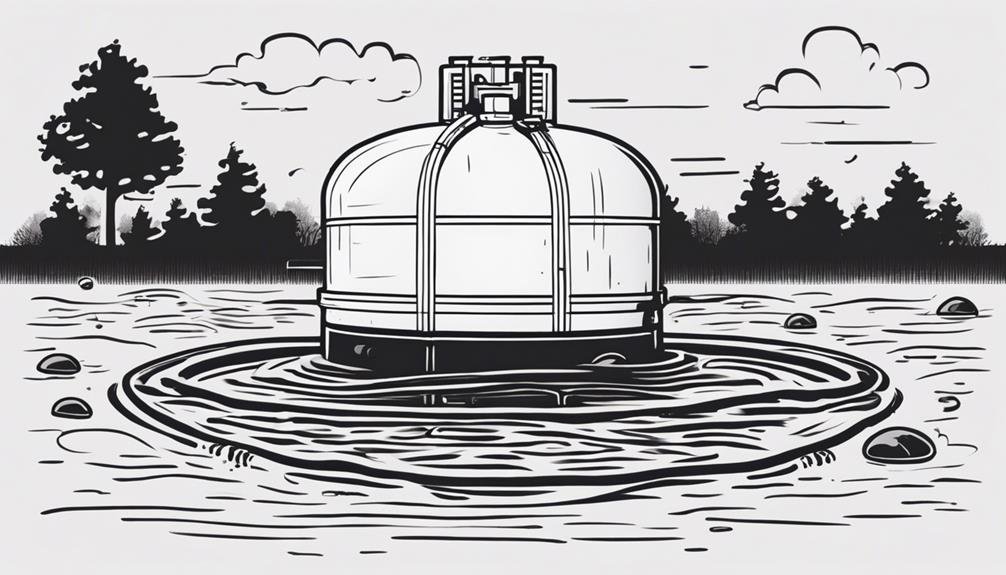If you're noticing slow drains and gurgling noises coming from your plumbing, you might not realize these could be signs of septic tank issues. However, there can be various reasons behind your septic tank showing problems, some of which may surprise you.
Understanding the underlying causes of these issues is crucial for maintaining the health of your septic system. By being aware of what to look out for, you can potentially address the root of the problem before it escalates further.
Key Takeaways
- Foul odors and slow drainage signal septic tank problems.
- Full tanks cause slow drains, odors, and sewage backups.
- Warning signs of system failure include odors and gurgling sounds.
- Visible symptoms like odors, slow drains, and lush grass indicate issues.
Common Signs of Septic Tank Problems

If you notice foul odors lingering around your property, it could be an early indication of septic tank issues. One common sign of septic tank problems is issues with the drain field. The drain field is responsible for filtering and dispersing the liquid that exits the septic tank. If you observe soggy areas around the drain field or notice sewage surfacing above it, this could point to a problem with your septic system.
Another potential issue to be aware of is root intrusion. Trees and shrubs near your septic tank and drain field can sometimes send roots into the pipes, causing blockages or damage. Signs of root intrusion include slow drainage, gurgling sounds in the pipes, or sewage backups in your home.
Regular inspections and maintenance can help prevent these problems. If you suspect any septic tank issues, it's advisable to contact a professional to assess the situation promptly.
Indications of a Full Tank
Monitoring the level of waste in your septic tank is crucial to prevent potential backups and system failures. To ensure your septic system functions optimally, here are some key indications that your tank may be full:
- Slow Draining Fixtures: If you notice slow drainage in sinks, showers, or toilets, it could signal a full septic tank.
- Odors: Foul smells both inside your home and around the septic tank area may indicate a full tank.
- Pooling Water: Water pooling in your yard, especially near the septic tank or drain field, suggests a full tank unable to handle more waste.
- Lush Grass: While a healthy lawn is desirable, an unusually lush and green patch above the septic tank can indicate excess nutrients from a full tank.
- Backup: In extreme cases, sewage backups in toilets and drains are clear signs of a full septic tank in need of attention.
Regular pumping is crucial to prevent these issues. For most households, septic tanks should be pumped every 3 to 5 years. Proper maintenance and adherence to pumping frequency can help avoid costly repairs and keep your septic system in good working order.
Warning Signals of a Failing System

To identify warning signals of a failing septic system, pay close attention to subtle changes in your household's plumbing and the surrounding environment. One key indicator is foul odors emanating from drains or the yard, suggesting possible leaks or overfilled tanks. Slow drainage in sinks, showers, or toilets could signal a blockage or impending system failure. Additionally, gurgling noises from plumbing fixtures may indicate a backup in the system. Monitoring the grass above the septic tank for unusually lush or soggy patches can also reveal underlying issues.
Regular maintenance is crucial in preventing septic system failures. Schedule routine inspections and pump-outs as recommended by professionals to avoid costly repairs. Implement effective odor control measures by using bacterial additives designed to break down waste and reduce odors. Avoid flushing non-biodegradable items down the drain to prevent clogs and system malfunctions. By staying vigilant and following maintenance tips, you can prolong the lifespan of your septic system and minimize the risk of failures.
Visible Symptoms of Septic Tank Issues
What're the telltale signs that indicate your septic tank is experiencing issues? When it comes to visible symptoms of septic tank problems, there are key indicators to watch out for:
- Odor Detection: Foul smells around your yard or inside your home can be a clear sign that your septic system isn't functioning properly.
- Drainage Problems: Slow draining sinks, showers, or toilets can signal a potential issue with your septic tank's ability to handle wastewater effectively.
- Lawn Damage: Lush, green patches of grass above the septic tank area may indicate a leak, while unusually soggy or sunken areas could point to a drainage problem.
- Backup Prevention: Taking action before backups occur is crucial. If you notice gurgling sounds from drains or water pooling around the septic tank, it's time to investigate.
Being attentive to these visible symptoms can help you address septic tank issues promptly, preventing more significant problems down the line.
Conclusion
In conclusion, it's crucial to pay attention to the common signs of septic tank problems such as foul odors, slow drains, and soggy patches in your yard. Ignoring these warning signals could lead to costly repairs and potential health hazards.
Remember, a failing septic system can create a messy and unpleasant situation for you and your family. Stay vigilant and address any issues promptly to avoid a major septic tank disaster.

